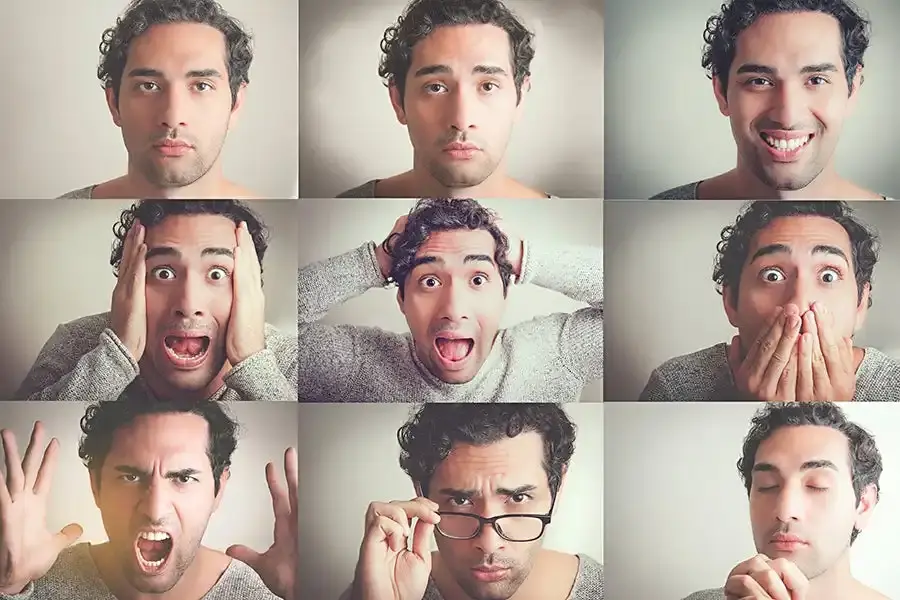The Eyes Have It: Mastering Facial Expressions in Scripts
- khailareyno
- Apr 22, 2024
- 5 min read
Updated: Apr 28, 2024

In screenwriting, facial expressions are pivotal for conveying emotions and subtext. A character's facial expressions can reveal their innermost thoughts, feelings, and motivations, adding depth and complexity to the story. Mastering the art of describing facial expressions in scripts is essential for creating vivid and compelling characters and enhancing the emotional impact of the story.
Facial expressions can communicate a wealth of information without a single word spoken. A subtle twitch of the lip, a furrowed brow, or a widening of the eyes can speak volumes about a character's emotional state. These expressions add layers of depth and complexity to the characters, making them more relatable and engaging for the audience.
Describing facial expressions in scripts requires a keen understanding of human emotions and how they manifest physically. It involves using precise and evocative language to paint a vivid picture of the character's emotional state. Instead of simply stating the emotion, writers must delve deeper, describing the specific movements and changes in the character's face that convey that emotion.
Reading Facial Expressions Introduction | Everyday Speech
Mastering facial expressions in scripts means using descriptive words to show emotions and reactions that actors can express visually on screen.
Here's a guide on how to achieve this effectively:
Observe and Understand Facial Expressions
To incorporate realistic and meaningful facial expressions into your scripts, start by observing real-life expressions and understanding the emotions they convey. Take note of the subtle changes in facial muscles and features that accompany different emotions. For example, a smile isn't just about the lips; it also involves the eyes and cheeks.
Study the different muscles involved in facial expressions and how they work together to create nuanced emotions. For instance, the furrowing of the brow can indicate confusion or concentration, while raised eyebrows can signal surprise or disbelief.
Use Specific and Evocative Language
When you're describing facial expressions in your script, aim for specific and vivid language that creates a clear mental image for the reader. Instead of a generic statement like "he looks sad," you could use more detailed descriptions like "his eyes well up with tears, and his lower lip trembles," which paints a more vivid and emotional picture. This approach helps the reader visualize the character's emotions and enhances the impact of the scene.
Consider Context
When considering how to describe facial expressions in your script, it's crucial to take into account the context of the scene and how it shapes the character's emotions.
For instance, a character might display a nervous smile when meeting someone for the first time, or furrow their brow in concentration when grappling with a challenging problem. The context of the scene, such as the character's surroundings, the events leading up to the moment, and the character's personality traits, all play a role in determining how their facial expressions are interpreted.
Additionally, remember that a smile or frown can carry different meanings depending on the character and the specific circumstances they find themselves in, so consider these factors carefully when describing facial expressions in your script.
Show, Don't Tell
When you choose to describe a character's facial expressions rather than explicitly stating their emotions, you invite the audience to engage more deeply with the story. By leaving room for interpretation, you allow viewers to connect with the characters on a more personal level, drawing them into the narrative. This approach makes the storytelling more dynamic and immersive, as the audience becomes an active participant in deciphering the characters' feelings. It also adds layers of complexity to the characters, making them more relatable and human. Instead of being told how to feel, the audience is given the opportunity to empathize and relate to the characters' experiences, creating a richer and more memorable viewing experience.
Here's an example:
EXT. ABANDONED HOUSE - NIGHT
The house looms in the darkness, its windows boarded up and its paint peeling. The front door creaks open, revealing JANE, mid-30s, cautiously stepping inside. She shines a flashlight around, illuminating the dusty, decrepit interior.
As Jane explores, she comes across a child's room. The walls are adorned with colorful drawings, now faded and torn. Jane's flashlight lands on a small, tattered teddy bear sitting on the floor. She picks it up, her expression pained as she remembers a long-forgotten memory.
Instead of explicitly stating that Jane is sad or nostalgic, the script uses visual cues—such as the abandoned house, the child's room, and the teddy bear—to convey her emotions, allowing the audience to interpret her feelings based on what they see.
Use Subtext
Facial expressions are a powerful tool in screenwriting for conveying subtext and adding depth to a scene. They allow characters to communicate their true feelings and intentions, even when their words may suggest otherwise.
Take, for instance, a character might wear a polite smile while actually feeling jealous or resentful inside. This contrast between their outward expression and inner emotions adds depth to the character, making them more multi-dimensional and true to life. Additionally, it intrigues the audience, prompting them to delve deeper into the character's psyche and interpret their true sentiments based on their facial expressions.
Balance Expressions with Dialogue
While facial expressions are a powerful tool in screenwriting, using them excessively can be distracting and diminish their impact. It's important to use facial expressions judiciously, reserving them for moments when they truly add meaning to the scene.
Facial expressions should work in harmony with the dialogue, enhancing its impact rather than overshadowing it. They can convey subtle emotions and nuances that might not be explicitly stated in the dialogue, enriching the audience's understanding of the characters and the story.
For example, a character's smile could convey warmth and friendliness, but if used too frequently, it may lose its impact and become less meaningful. However, if the same character rarely smiles but does so during a particularly poignant moment, the smile becomes more significant and memorable.
Here's an example of how to balance facial expressions with dialogue in a script:
INT. LIVING ROOM - DAY
SARAH, 30s, sits on the couch, reading a letter. Her husband, JACK, 40s, enters the room, looking concerned.
JACK
What's wrong, Sarah? You look upset.
SARAH
(looking up, forcing a smile)
Oh, it's nothing, just some bad news.
Jack sits beside her, placing a comforting hand on her shoulder.
JACK
(softly)
You can tell me, Sarah. I'm here for you.
Sarah's smile fades, and she looks down at the letter, tears welling up in her eyes.
SARAH
(voice breaking)
It's my grandmother. She's... she's gone.
Jack pulls her into a comforting embrace as she breaks down, crying.
In this example, the dialogue conveys the basic information of the scene, but Sarah's facial expressions add depth to her emotions. Her initial forced smile and Jack's concern set the tone for the scene, and as she begins to share her news, her facial expressions and body language reveal her true feelings, enhancing the emotional impact of the moment.
4 Steps to Writing Better Facial Expressions | Lisa Karsen
For more insights into facial expressions, click on the link!
https://imotions.com/blog/learning/research-fundamentals/facial-expressions-a-complete-guide/#:~:text=Happiness%20%E2%80%94%20raised%20cheeks%2C%20raised%20lip,mouth%2C%20lifted%20eyelids%20and%20eyebrows.


